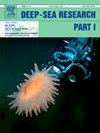地中海水域对深海动物群有多不利?基于“BALGIM”探险队软体动物的直布罗陀交换研究
IF 2.1
3区 地球科学
Q2 OCEANOGRAPHY
Deep-Sea Research Part I-Oceanographic Research Papers
Pub Date : 2025-03-25
DOI:10.1016/j.dsr.2025.104492
引用次数: 0
摘要
BALGIM探险队的目的是评估从加的斯湾到地中海跨越直布罗陀海峡的海洋生物的分布。200米以下共进行了99次拖运,深度达到2110米。利用本研究的腹足类、桨足类和双壳类的数据构建了两个丰度数据矩阵。根据水深和地理分布对物种进行评分,分为(1)只生活在大西洋的深海物种,或(2)同时生活在大西洋和地中海的深海物种。活体捕获的软体动物有154种,共捕获4641只,是仅采集贝壳类软体动物的2倍(243只)。这些样本并没有根据它们的区系成分形成明确的集群。超过一半的种类(84种)同时生活在地中海和大西洋。62种只分布在大西洋的种类中,大多数与摩洛哥边缘600米以下的凉爽或寒冷水域有关,并且在加的斯湾北部被地中海流出水所阻挡。有四种喜欢温暖但低盐的北大西洋中部水域,也在摩洛哥边缘。地中海流出的大部分物种也出现在地中海,而没有地中海只有深海的物种。因此,与温度相比,1 ~ 2‰范围内的盐度变化并不重要,这解释了大多数限制分布。本文章由计算机程序翻译,如有差异,请以英文原文为准。
How adverse are Mediterranean waters to the deep-sea fauna? A study of the Gibraltar exchange based on Mollusca from the “BALGIM” expedition
The BALGIM expedition was designed to assess the distribution of marine organisms in the transition from Gulf of Cadiz to Mediterranean Sea across the Strait of Gibraltar. There were 99 hauls below 200 m depth, down to 2110 m. Two matrixes with abundance data were constructed using the data of gastropods and scaphopods from this study and those of bivalves studied earlier. Species were scored according to their bathymetric and geographic distribution as (1) deep-sea species occurring exclusively in the Atlantic, or (2) deep-sea species reported as living both in the Atlantic and the Mediterranean. A total of 4641 live-taken individuals corresponding to 154 species of molluscs collected alive were identified, and almost twice as many (243 species) including those collected as shells only. The samples do not form clearly defined clusters based on their faunal content. More than half of the species (84) occur both in the Mediterranean Sea and the Atlantic Ocean. Most of the 62 species with an Atlantic-only distribution are associated to the cool or cold waters below 600 m depth along the Moroccan margin, and are barred by the Mediterranean Outflow Water in the northern part of Gulf of Cadiz. Four species are preferent of the warm but low-saline North Atlantic Central Water, also off the Moroccan margin. The Mediterranean outflow largely shares a set of species also occurring in the Mediterranean, whereas there are no Mediterranean-only deep-sea species. Therefore, variation in salinity in a range of 1–2 ‰ is not critical compared to temperature which explains most of the restricted distributions.
求助全文
通过发布文献求助,成功后即可免费获取论文全文。
去求助
来源期刊
CiteScore
4.60
自引率
4.20%
发文量
144
审稿时长
18.3 weeks
期刊介绍:
Deep-Sea Research Part I: Oceanographic Research Papers is devoted to the publication of the results of original scientific research, including theoretical work of evident oceanographic applicability; and the solution of instrumental or methodological problems with evidence of successful use. The journal is distinguished by its interdisciplinary nature and its breadth, covering the geological, physical, chemical and biological aspects of the ocean and its boundaries with the sea floor and the atmosphere. In addition to regular "Research Papers" and "Instruments and Methods" papers, briefer communications may be published as "Notes". Supplemental matter, such as extensive data tables or graphs and multimedia content, may be published as electronic appendices.

 求助内容:
求助内容: 应助结果提醒方式:
应助结果提醒方式:


